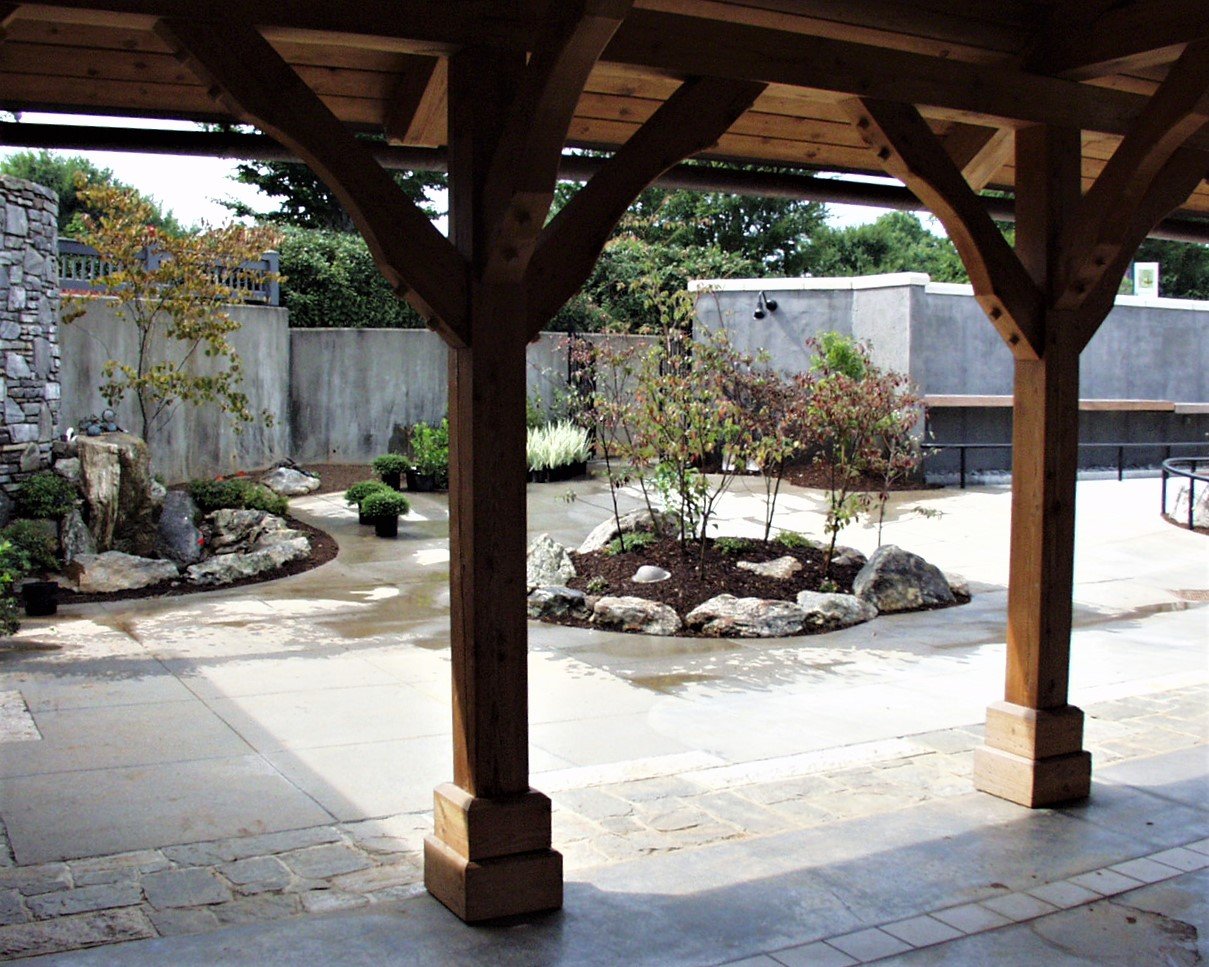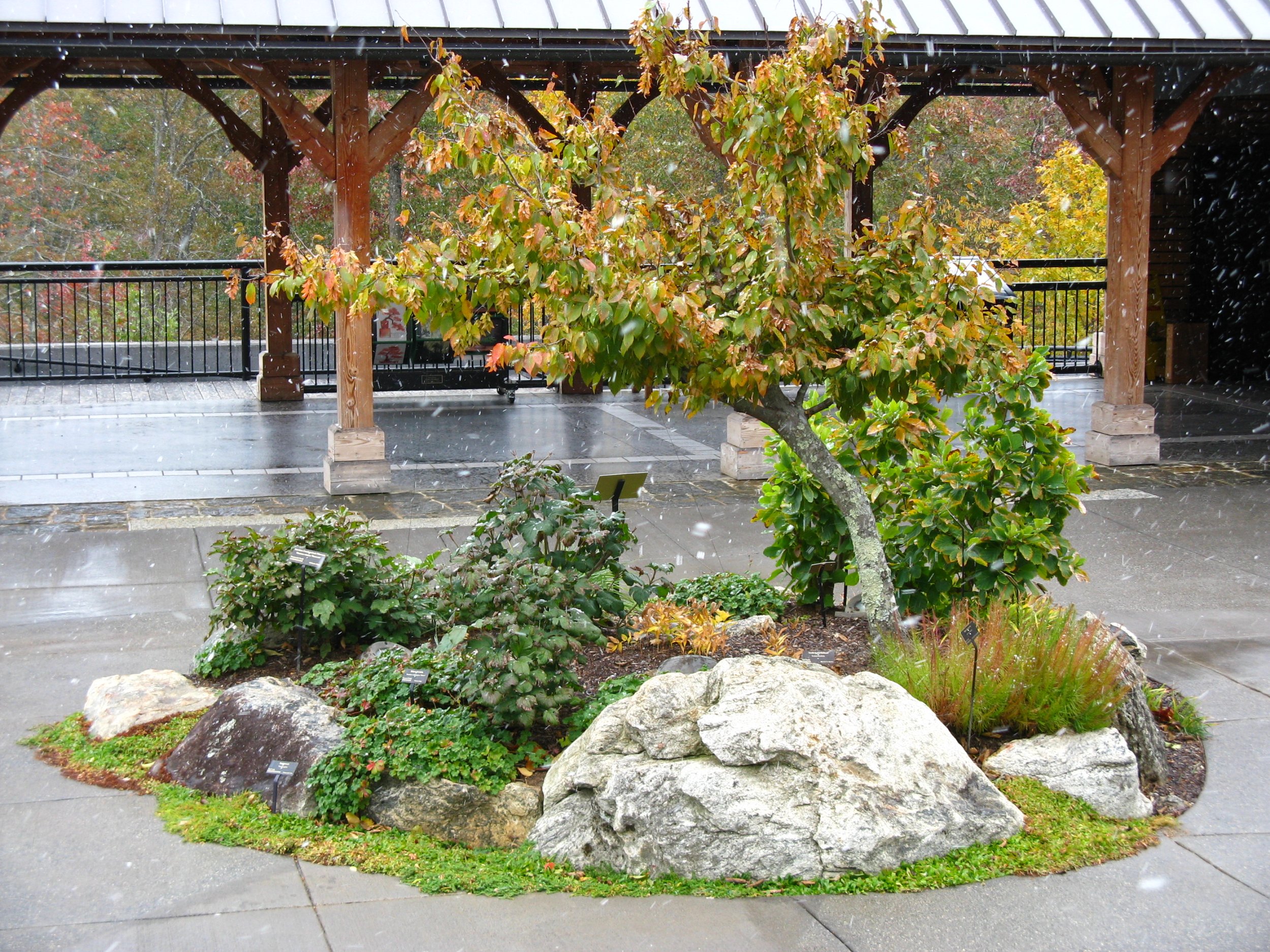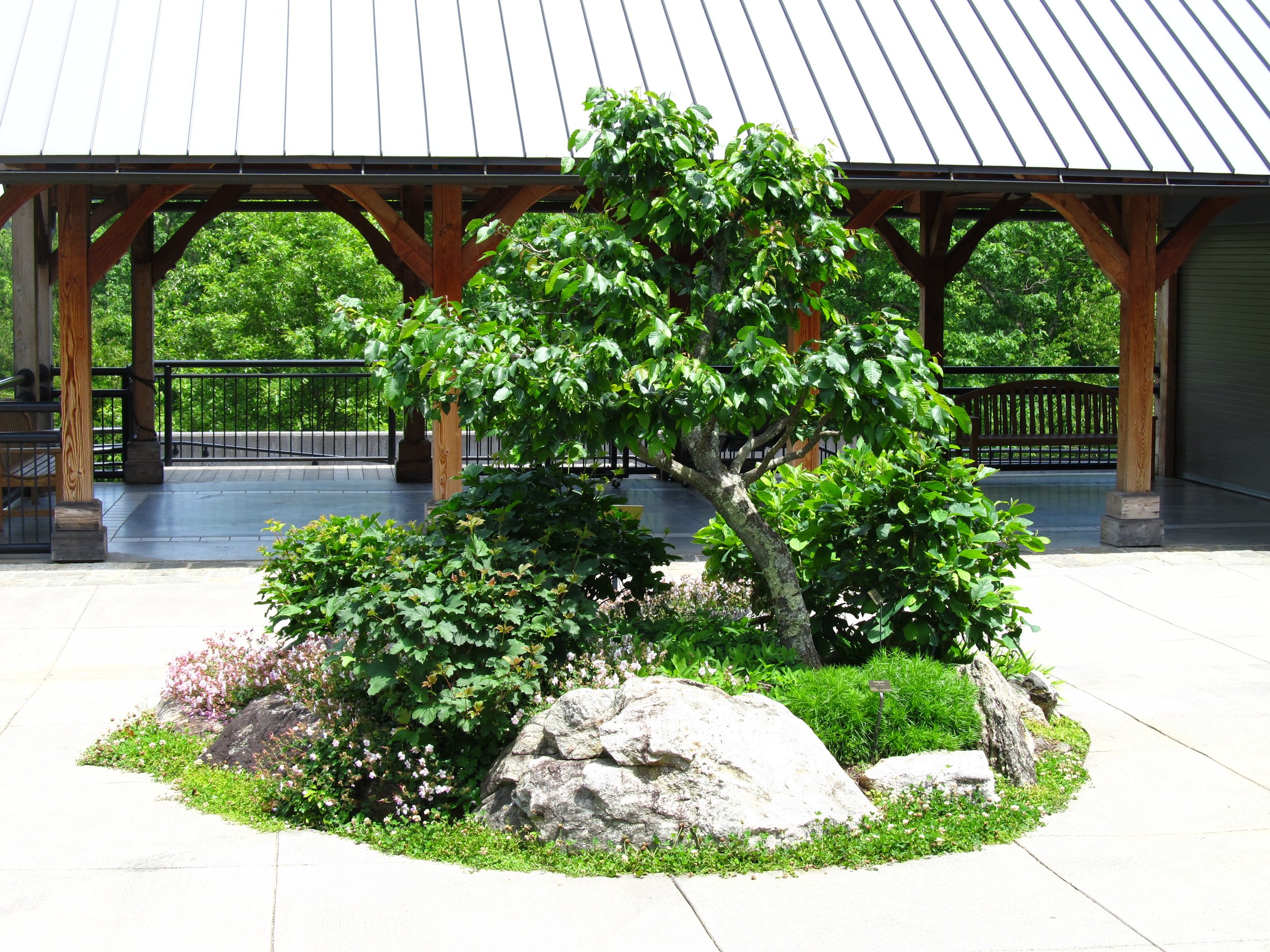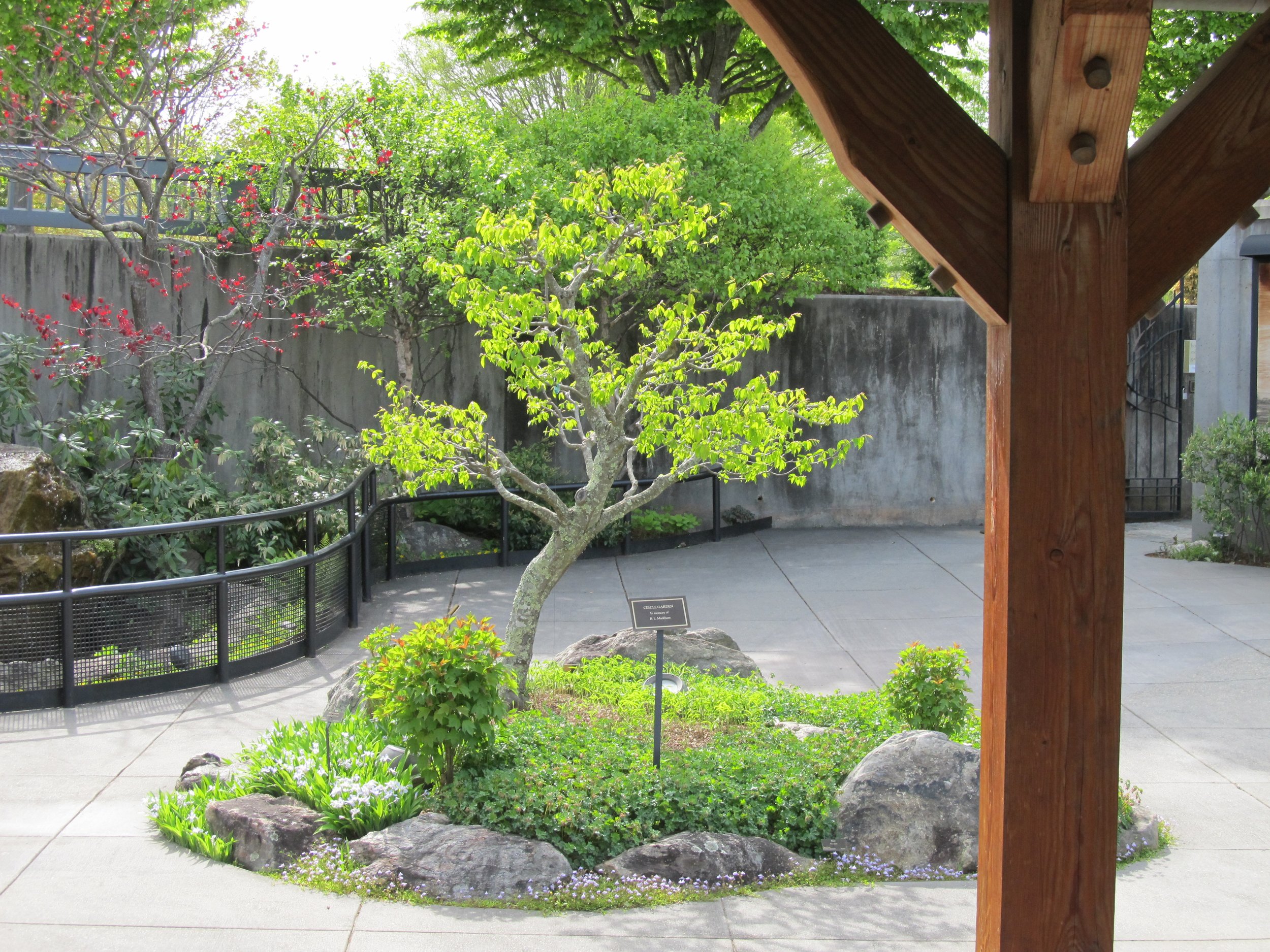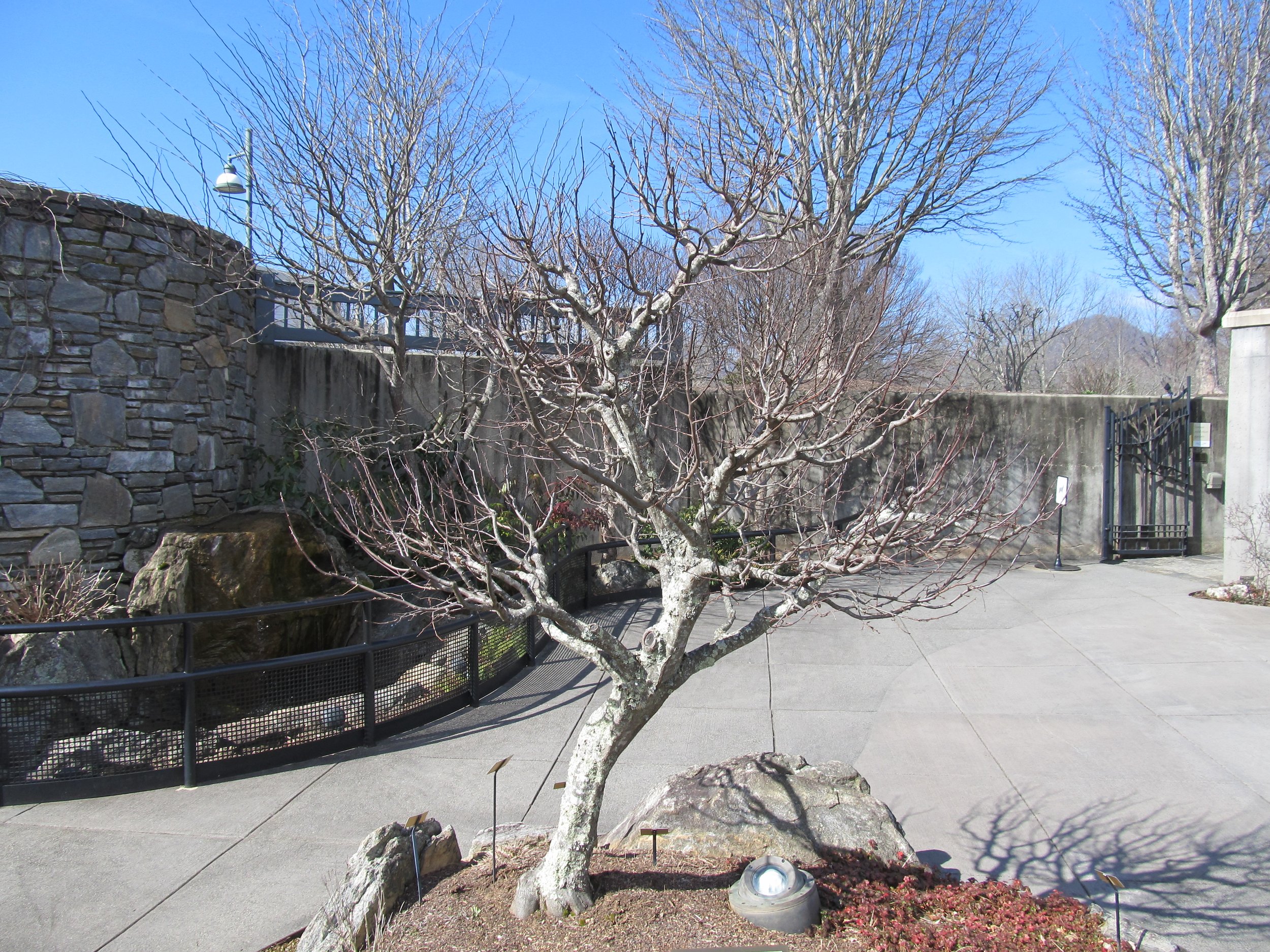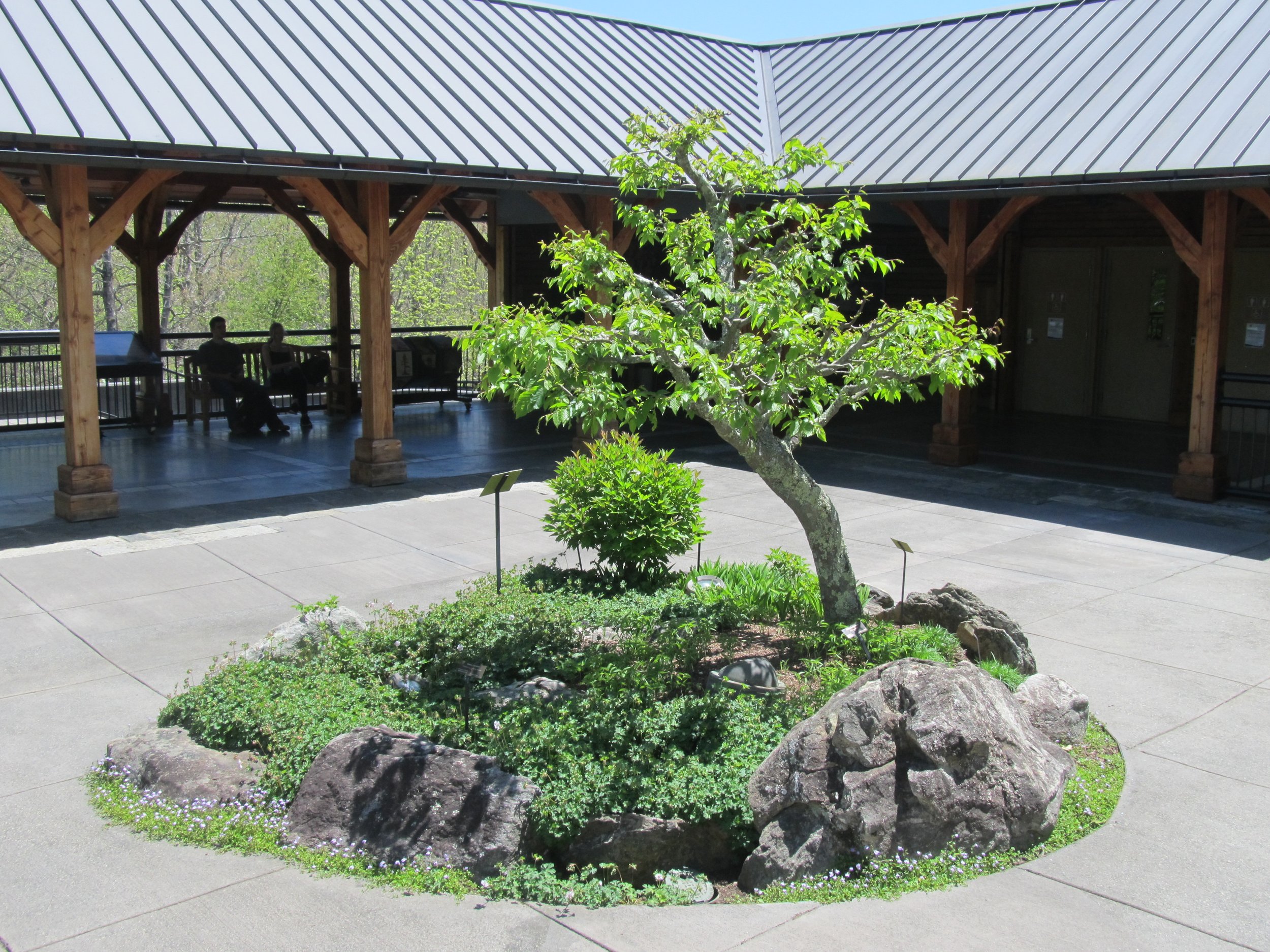The Circle Garden
In the center of the plaza just inside the upper entrance to the Bonsai Exhibition Garden is a circular-shaped garden bed, known appropriately enough as the Circle Garden. Planted within this space is a specimen American hornbeam (Carpinus caroliniana), which is pruned every year in early spring prior to new leaves emerging. I did that work recently, so I have been thinking about that tree and the Circle Garden planting, recalling its history as a prominent feature of the bonsai garden.
Here is a current image showing the tree looking trim and ready for another growing season:
This first pruning of the season is precise and highly detailed. Every single twig on the tree is assessed and almost all are at least shortened, with many being removed entirely. With this initial shaping the tree is prepared for another growing season. Before long fresh new foliage will appear, as seen in this photograph from 2022:
The look of the hornbeam at this stage of seasonal development is very appealing, as the leaves are a sprightly light green and unblemished, and the underlying branch structure can still be seen through openings in the foliage mass. Part of the appeal of this look is its transient nature. As spring continues the new leaves increase in size and number as shoots keep elongating, and in just a few weeks the look of the tree is very different. The crown grows larger and denser and gradually the interior of it can no longer be visually penetrated. Random shoots, growing more vigorously than their neighbors, start poking out all over, giving the tree a shaggy, unkempt look:
The foliage itself is still fresh and unblemished; there is just too much of it. The excess spoils the illusion of a miniaturized tree and instead presents the image of a rangy bush on a stick, which is not a good look in the bonsai garden. Unfortunately, while this specimen is getting overgrown, the same is happening to all the other specimen plantings in the garden, and to the bonsai on display. That is spring in a nutshell — an explosion of growth everywhere, all at once.
Eventually, we catch up with it. Here is how the tree looks after its second pruning of the year:
Here is a view from the opposite direction:
The first pruning is done in detail, to get the structure of the bare tree organized while it is still visible. The second pruning is reactive. Once the tree has pushed out so much new growth that the shape of the crown loses definition and looks sloppy, it is necessary to chase back the excess and restore order. Failure to do this job in a timely manner can result in unintended damage. New shoots might extend a foot or two in length and carry more than a dozen large leaves, at which point the shoots can no longer reliably support their own weight and are at risk of breaking if a strong wind blows through. That is a sort of natural pruning, but it is random and unconcerned with design.
The denseness of the new growth makes it difficult to do much beyond pruning the crown of the tree as a single mass, focusing on its outline, or silhouette. That is all that can be reasonably maintained throughout the rest of the growing season. In a year with sufficient rain, this particular hornbeam will require five or six prunings to keep it looking compact and right for the prestigious place it occupies.
As the growing season unfolds any number of issues might come into play, including insect and fungal activity, damage from severe weather such as hail storms or hurricane winds, drought, or simply being exposed day after day to intense sun and heat as a result of being out in an open plaza surrounded by paving. This image from August of 2022 shows the hornbeam and the other plantings in the circular garden bed looking lush and healthy in late summertime:
Here is the view six weeks later, as autumn coloration begins:
The American hornbeam in this particular planting does not feature vibrant autumn color (some hornbeams do and some don't), but the other plantings in the garden bed provide support. The two red shrubs on the left side of the planting when seen from the perspective shown in the above image are dwarf American cranberrybush (Viburnum trilobum 'Compactum'). The yellow herbaceous plants around the base of the hornbeam are sessile-leaved bellwort (Uvularia sessilifolia), and the large patch of ground cover is Biokovo geranium (Geranium x cantabrigiense 'Biokovo'). The geraniums can be seen flowering in the springtime images. Around the periphery of the planting bed is a small-leaved plant called mazus (Mazus reptans) that blooms a pale purple color in spring, and the grass-like plant on the far left of the bed is dwarf crested iris (Iris cristata 'Vein Mountain'). That's a lot of plant material in a fairly small bed, and there are several large rocks too. Altogether it forms a visually engaging little scene.
The appearance of the Circle Garden is very different now compared to how it was when the bonsai garden opened in 2005, and the change is due to more than simply the plant development achieved in the passage of time. As originally designed and planted, the Circle Garden featured ten young trees in an arrangement similar to a grove-planting bonsai. It was a completely serviceable idea, but undermined by poor plant selection. The tree species chosen was pagoda dogwood (Cornus alternifolia), a plant native to this part of the world but in nature typically found growing in the forest understory. That is to say, it likes being in at least partial shade. The Circle Garden is situated in the middle of a concrete plaza under an unblinking sun. The pagoda dogwoods were plain unhappy with the heat and exposure, and no amount of irrigation could help.
Here is a photograph made in the final days of bonsai garden construction, when the landscape was being planted. Note the potted plants on the far side of the plaza, waiting to be put in the ground:
2005
The group planting of pagoda dogwoods struggled through one growing season, and then an alternative scheme for the Circle Garden was in order. The replanting of that space was presented as a live educational demonstration program at the 2006 Carolina Bonsai Expo. My South Carolina bonsai friends — Ken Duncan and John Geanangel — were on hand and together we installed a new arrangement, featuring the American hornbeam that is still there today. Instead of a grove planting, the new Circle Garden was done as a large-scale tray landscape. There was no tray, of course, but the cutout in the center of the plaza does create a planting bed that functions in a way similar to a large pot (click on any image in the gallery for a larger view):
The American hornbeam we used for the Circle Garden had previously been part of a different Arboretum landscape planting, but was removed because it had a more noticeably crooked trunk than the other trees with which it had been planted. The rejected hornbeam was in a storage area for several years when I noticed it and asked about its availability. The same crooked trunk that was previously seen as a flaw made the tree attractive for its new assignment. Here is what the new Circle Garden planting looked like after the dust had settled:
2006
The following gallery shows images of the Circle Garden made over the course of the next decade after the 2006 replanting. In addition to showing how the hornbeam grew and was gradually shaped, it is interesting to note how the secondary plants are changed out about half way through the sequence (click on the first image for larger view and then scroll through to see how the transformations occurred):
Observe the drastic alteration to the American hornbeam that takes place between the times when the next two images were made:
2017
2019
I decided to substantially lower the height of the tree and removed the top in 2018. A shorter, broader crown seemed better for what the hornbeam was supposed to represent: a gnarled old tree like one would see growing in a rugged location up in the mountains. Because this particular specimen is not actually very old, that rugged character has to be instilled through pruning. To be honest, another motivation for dropping the height of the tree was to keep it within reach so that I wouldn't need to stand on a ladder when pruning the upper reaches of the crown. There is nothing wrong with being practical!
Initially the reconfigured hornbeam looked a little awkward to me, perhaps because I was used to seeing it a certain way for so long and then the look of the tree suddenly changed. In any event, in subsequent years the tree has grown into its new form, and now I am pleased with its shortened appearance.
2020
2023
You may have noticed the sign in the planting bed, standing up prominently in nearly every picture. Here is what it says:
Mr. Bunky Markham was a bonsai enthusiast from Roanoke, Virginia, and a longtime member of the Hinoki Bonsai Society. He passed away before the bonsai garden was built, but his wife and family were generous contributors to the fundraising effort that made the garden possible. Mrs. Dana Markham is still an avid supporter of bonsai at The North Carolina Arboretum, and she had the Circle Garden named for her beloved husband.








